Last updated on May 15th, 2022 at 10:30 am
The Pituitary Gland
For nursing students the endocrine system can be difficult to learn. We will attempt to guide you through the very basics and hopefully this will help develop a grasp of the endocrine system. Today we will start with the pituitary gland.
The pituitary gland is also referred to as the master gland. Due to the fact that most of its hormones dominate other areas of the endocrine system such as the testes, thyroid gland, ovaries, and adrenal glands.
The pituitary gland is located at the base of the brain. It is pea-sized and sits in a bony enclosure called the sella turcica. There are two regions to the pituitary gland, the anterior and posterior pituitary.
Anterior Pituitary Gland
The anterior pituitary is the larger of the two regions. The anterior pituitary produces six hormones.
- Adrenocorticotropic hormone (ACTH): ACTH stimulates the adrenal glands to produce hormones.
- Growth hormone (GH), or somatotropin: Crucial in maintaining healthy body composition and growth in children. In adults, it assists in muscle mass, healthy bone, and affects fat distribution.
- Thyroid stimulating hormone (TSH): activates the thyroid gland to produce hormones
- Follicle-stimulating hormone (FSH): works with LH for functioning of the testes and ovaries.
- Luteinizing Hormone (LH): works with FSH for functioning of the testes and ovaries.
- Prolactin: stimulation of milk production.
NMEUMONIC:
Anterior Pituitary Hormones
For the anterior pituitary, the mnemonic will start with a “A”
A : Adrenocorticotropic hormone (ACTH)
Girl: Growth hormone (GH)
Told: Thyroid stimulating hormone (TSH)
People: Prolactin
Funny: Follicle-stimulating hormone (FSH)
Lies: Luteinizing Hormone (LH)
The Posterior Pituitary Gland:
The posterior pituitary contains nerve cells from the hypothalamus, and is directly responsible for sending hormones directly to the posterior lobe via these nerves, once these hormones are received from the hypothalamus, the pituitary then releases them.
Posterior lobe hormones:
Oxytocin: contraction of the uterus during childbirth and stimulates milk production.
Anti-diuretic hormone (ADH): stimulates the kidneys to increase water absorption in the blood.
Pituitary Disorders:
 The most frequent type of disorder is a pituitary gland tumor. These occur frequently in adults. These are not the same as brain tumors. Luckily these pituitary gland tumors are usually always benign. Actual pituitary gland cancers are very rare.
The most frequent type of disorder is a pituitary gland tumor. These occur frequently in adults. These are not the same as brain tumors. Luckily these pituitary gland tumors are usually always benign. Actual pituitary gland cancers are very rare.
If a pituitary gland tumor is suspected, one would need to watch for the following:
- Hypersecretion: a secretory pituitary tumor can cause too much of any hormone to be secreted in the body.
- Hyposecreation: If there is too little of any hormone in the body this can be caused by an enlarged pituitary tumor. The size of the large gland interferes with the production of hormones. Radiation and/or surgery of the tumor and can also cause hyposecretion of the hormones.
- Tumor or mass consequences: as the pituitary gland grows it can press against the gland and other areas of the brain. Which can cause headaches, visual disturbances, and other health challenges.
Anterior Pituitary Disorders:
Hypopituitarism: Under secretion of hormones.
- Severe weight loss
- Atrophy of all endocrine glands and organs
- Hair loss
- Impotence
- Amenorrhea
- Hypoglycemia
Hyperpituitarism: Over secretion of hormones.
- Acromegaly – adults
- Broad skull, protruding jaw, broadening of hands and feet
- Thick tongue
- Enlarged hands and feet
- Decreased libido
- Amenorrhea
- Impotence
Posterior pituitary disorders:
- Diabetes Insipidus: Disrupts the storage, production and release of ADH.
- SIADH: Excessive ADH activity, with water retention and diluted hyponatremia.
As you can see the pituitary gland really is the “Master Gland” of the body.
Anna Curran, RN, BSN, RN-BC, CMSRN, PHN


